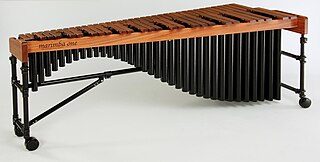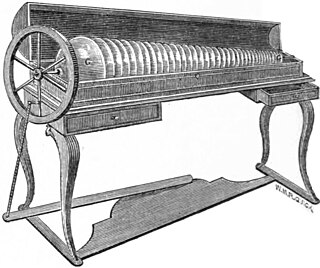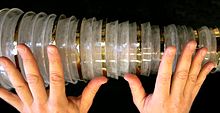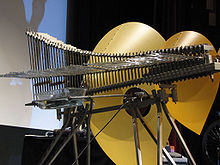
A percussion instrument is a musical instrument that is sounded by being struck or scraped by a beater including attached or enclosed beaters or rattles struck, scraped or rubbed by hand or struck against another similar instrument. Excluding zoomusicological instruments and the human voice, the percussion family is believed to include the oldest musical instruments. In spite of being a very common term to designate instruments, and to relate them to their players, the percussionists, percussion is not a systematic classificatory category of instruments, as described by the scientific field of organology. It is shown below that percussion instruments may belong to the organological classes of idiophone, membranophone, aerophone and chordophone.

The xylophone is a musical instrument in the percussion family that consists of wooden bars struck by mallets. Like the glockenspiel, the xylophone essentially consists of a set of tuned wooden keys arranged in the fashion of the keyboard of a piano. Each bar is an idiophone tuned to a pitch of a musical scale, whether pentatonic or heptatonic in the case of many African and Asian instruments, diatonic in many western children's instruments, or chromatic for orchestral use.

The marimba is a musical instrument in the percussion family that consists of wooden bars that are struck by mallets. Below each bar is a resonator pipe that amplifies particular harmonics of its sound. Compared to the xylophone, the marimba has a lower range. Typically, the bars of a marimba are arranged chromatically, like the keys of a piano. The marimba is a type of idiophone.

The vibraphone is a percussion instrument in the metallophone family. It consists of tuned metal bars and is typically played by using mallets to strike the bars. A person who plays the vibraphone is called a vibraphonist,vibraharpist, or vibist.

An idiophone is any musical instrument that creates sound primarily by the vibration of the instrument itself, without the use of air flow, strings (chordophones), membranes (membranophones) or electricity (electrophones). It is the first of the four main divisions in the original Hornbostel–Sachs system of musical instrument classification. The early classification of Victor-Charles Mahillon called this group of instruments autophones. The most common are struck idiophones, or concussion idiophones, which are made to vibrate by being struck, either directly with a stick or hand or indirectly, with scraping or shaking motions. Various types of bells fall into both categories. A common plucked idiophone is the Jew's harp.

The glass harmonica, also known as the glass armonica, glass harmonium, bowl organ, hydrocrystalophone, or simply the armonica or harmonica, is a type of musical instrument that uses a series of glass bowls or goblets graduated in size to produce musical tones by means of friction. It was invented in 1761 by Benjamin Franklin.

The music of Guatemala is diverse. Music is played all over the country. Towns also have wind and percussion bands that play during the lent and Easter-week processions as well as on other occasions. The marimba is an important instrument in Guatemalan traditional songs. The oldest documented use of marimba in the Americas dates to 1680 during celebrations at Santiago de los Caballeros de Guatemala.

Leigh Howard Stevens is a marimba artist best known for developing, codifying, and promoting the Stevens technique or Musser-Stevens grip, a method of independent four-mallet marimba performance based on the Musser grip.

Lick My Decals Off, Baby is the fourth studio album by American musician Captain Beefheart and the Magic Band, released in December 1970 by Straight and Reprise Records. The follow-up to Trout Mask Replica (1969), it is regarded by some critics and listeners as superior, and was Van Vliet's own favorite of his albums. In his words, the title credo of the album was an encouragement to "get rid of the labels", and to evaluate things according to their merits.
A verrophone ("glass-euphonium") is a musical instrument, invented in 1983 by Sascha Reckert, which, "uses tuned glass tubes," open at one end and arranged in various sizes. The sound is made by rubbing one end of one or more of the glass tubes, or also by striking them or rubbing them with a special mallet. The tubes are close together so that chords can be played by rubbing more than one at the same time. The instrument carries more acoustical volume than the glass harmonica and some other glass instruments and generally has a range from G3 to F6. Every piece composed originally for glass harmonica can be played on the verrophone.

The glasschord is a struck crystallophone resembling the celesta, invented circa 1785 by physicist M. Beyer of Paris. It creates sound by using cloth covered wooden hammers to strike glass tubes laid on a cloth strip, with no dampeners. The instrument has a range of three octaves, in various models from c' to c'', f' to f'', and g' to g''. The instrument was largely inspired by the glass harmonica created by Benjamin Franklin, and was given the name glasschord by him. On 6 July 1785, Thomas Jefferson that Franklin carried a version of the instrument with him, describing it as a sticcado.
Struck idiophones is one of the categories of idiophones that are found in the Hornbostel-Sachs system of musical instrument classification.

A glass harp is a musical instrument made of upright wine glasses.
Richard Pockrich, Poekrich, or Puckeridge, was an Irish musician, and was the inventor of the glass harp around 1741.

James Graham (1745–1794) was a Scottish proponent of electrical cures, showman, and pioneer in sex therapy. A self-styled doctor, he was best known for his electro-magnetic musical Grand State Celestial Bed. Dismissed as a quack by medical experts, Graham apparently believed in the efficacy of his unusual treatments.

Gloria Parker was an American musician and bandleader who had a radio show during the big band era. The Gloria Parker Show was broadcast nightly from 1950 to 1957, coast to coast on WABC. She played the marimba, organ, and singing glasses. Dubbed Princess of the Marimba, she conducted the 21-piece Swingphony from the Kelly Lyceum Ballroom in Buffalo, New York. This was the largest big band led by a female bandleader. Edgar Battle and Walter Thomas were arrangers for the Swingphony.

A keyboard percussion instrument, also known as a bar or mallet percussion instrument, is a pitched percussion instrument arranged in the same pattern as a piano keyboard and played with hands or percussion mallets. While most keyboard percussion instruments are fully chromatic, keyboard instruments for children, such as ones used in the Orff Schulwerk, may be diatonic or pentatonic.
This family of musical instruments includes those whose primary material is glass. They may be played using percussive techniques, such as striking the glass to produce a sound, or by utilizing friction to generate a resonant sound. Many glass instruments produce an ethereal, otherworldly timbre. A well-known glass instrument is Ben Franklin's glass harmonica.
















